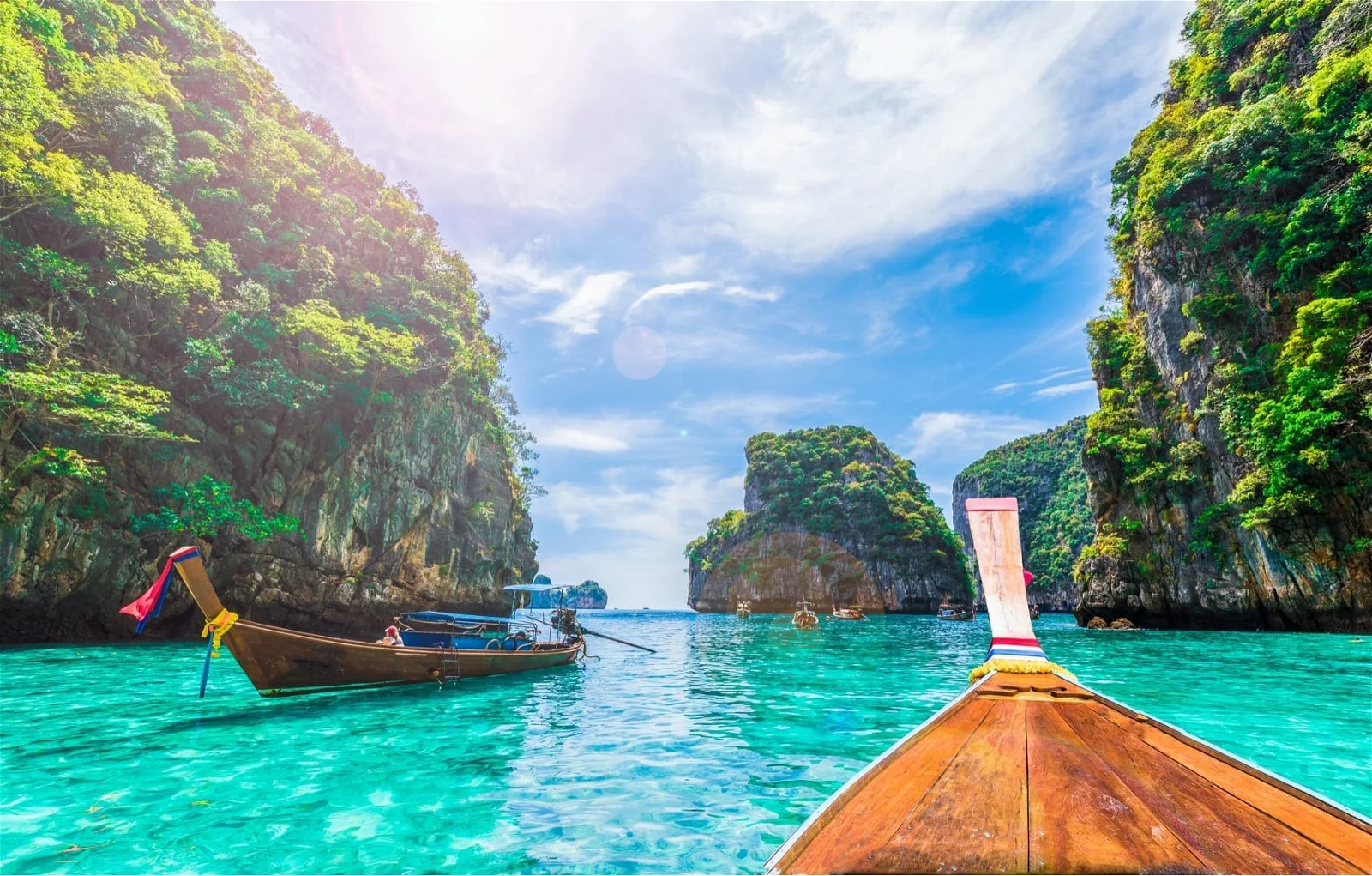For travelers seeking an exotic beach escape, fascinating cultural immersion, mouthwatering cuisine, and warm tropical weather, Thailand ranks as one of the world’s most alluring destinations. This Southeast Asian paradise entices visitors from around the globe with its ornate temples, bustling cities, island havens, and famously friendly locals.
Thailand’s peak travel season traditionally falls during the winter months from November through March when rainfall is low and temperatures are their most comfortable across popular areas like Bangkok, Phuket, Krabi, Chiang Mai, and the idyllic southern islands. However, summer also brings its own benefits that make visiting Thailand during these months worth considering.
To help you decide if the summer season from March through June is the right time for your own journey through the Land of Smiles, let’s take an in-depth look at both the advantages and potential drawbacks of visiting Thailand during this time of year:
The Upside of Summer in Thailand
While winter is unquestionably peak tourist season in Thailand, the summer months offer their own compelling perks and advantages that may outweigh some of the downsides for certain types of travelers:
Fewer Crowds & Lower Prices
By far one of the biggest draws of visiting Thailand during the hot and rainy summer season is the ability to avoid the peak tourist crowds that descend November through March. Fewer visitors mean you can often experience major attractions like Bangkok’s Grand Palace or Chiang Mai’s Night Bazaar in relative tranquility without battling hordes of tour groups.
Hotel rates at this time of year can be 20-50% lower than peak pricing across the country. You’ll also find plenty of deals on activities and excursions as local operators aim to lure visitors. Flight costs are frequently cheaper for summer arrivals too compared to the inflated winter prices when demand is highest.
While Thailand is never exactly deserted, summertime allows you to enjoy a more laidback, calm ambiance and fewer crowds at many famous sites, beaches, and destinations. Avoiding the constant swarms of foreign tourists makes it easier to connect with local culture when it’s not overrun with visitors.
Best Diving & Snorkeling Conditions
Thailand’s peak surface temperatures for diving and snorkeling along the Andaman Coast occurs during these warmer summer months. While the rains do affect underwater visibility at times, certain periods see excellent dive and snorkel conditions with warm 80-90°F water temps that attract diverse marine life.
Hotspots like the Similan Islands, Ko Lanta Yai, Hin Daeng & Hin Muang near Ko Lipe are at their most brilliant for seeing whale sharks, manta rays, and colorful coral formations. On the opposite coast, diving remains good around islands like Koh Samui and Koh Tao in the Gulf of Thailand as well.
With the right weather window, summer represents prime time for encountering Thailand’s kaleidoscope of undersea splendors in ideal conditions. Getting in the water allows you escape the heat while avoiding peak season crowds on the islands and beaches too.
Lower Risk of Natural Disasters
While the summer months do experience the brunt of Thailand’s tropical monsoon rainfall, this season also mercifully avoids the risk of other more severe natural disasters. The threat of typhoons and cyclones impacting Thailand is highest during the October to February time frame, while summer is in the clear.
High season in particular from July to October carries greater risks of disruptions due to typhoons affecting air travel and coastal areas. The chances of encountering catastrophic flooding like the tragic 2011 events are also lower during the summer season.
Of course the weather is still volatile and there are no guarantees, but summer provides a respite from the worst potential storms and a window of relative predictability compared to autumn or early winter. Advance planning and flexibility are wise, but nature’s fiercest tantrums are less likely to derail your plans.
The Downside of Summer in Thailand
With all those benefits laid out, the summer season in Thailand between March and June is far from perfect. Here are some key drawbacks to factor in when considering a summer visit:
Scorching Heat & High Humidity
Perhaps the biggest detriment to Thailand in the summer is the combination of sizzling heat and stifling humidity that envelops the country, especially areas like Bangkok, Koh Samui, and the Gulf Coast regions. Average highs in the mid 90s°F don’t sound too extreme until you factor in humidity levels of 70-90% throughout the summer months.
These steamy conditions can make spending extended periods outdoors challenging, whether you’re temple-hopping in Bangkok or trying to relax on the beach. While cooler outddor mornings and evenings provide some respite, the midday sun and mugginess often force visitors to seek air-conditioned refuges indoors during peak heat.
Humidity levels are somewhat less extreme in more northern areas like Chiang Mai and Chiang Rai. However, the islands, coastal regions, and Bangkok bear the brunt of the stifling summer steaminess.
Unpredictable Heavy Rainfall
Thailand’s summer monsoon season, particularly between July and October, brings periods of extreme rainfall that can quickly put a damper on travel plans and make navigating trickier whether by air, rail, or road. Torrential downpours and thunderstorms can strike with relatively little warning, flooding streets and putting a halt to outdoor activities and sightseeing.
In areas like Phuket and Koh Samui in the western Gulf, rainfall accumulations can range anywhere from 5-25 inches per month during the summer. Lighter rain may come and go quickly, but occasional widespread flooding poses risks too. This unpredictability makes advance planning challenging.
While certain regions like around Bangkok and the islands see more intense rainfall on average, precipitation patterns can vary significantly across Thailand’s diverse landscapes and microclimates. This means a popular island destination could remain sunny even as other areas get pounded by massive downfalls. Carefully monitoring forecasts and weather windows during summer is essential.
Island Beach Disappointments
Sadly, some of Thailand’s most beautiful islands are at their least photogenic during the summer rainy months. Heavier precipitation means rougher water conditions, lack of sunshine to enjoy the pristine sand beaches, and constant threats of storms disrupting boat travel and coastal activities.
Unlike winter when you encounter scenes of postcard-perfect turquoise bays and sandy coves, summer visits to islands like Phuket, Phi Phi, Koh Samui and others tend to feature browner, choppy waters and fewer opportunities to soak up that blissful seaside ambiance. Coral can also become obscured by lower visibility underwater for snorkeling and diving too.
However, summer’s stormy weather patterns can still offer lucky visitors occasional windows of idyllic, sun-drenched calm across the islands. Taking advantage of these pocket reprieves is key if your heart is set on enjoying Thailand’s stunning beaches and isles at their most gleaming.
The Takeaway: Summer’s Pros and Cons in Thailand
In the end, whether summer is right for visiting Thailand depends entirely on your travel priorities, budget, and ability to handle heat and unpredictable weather. If your focus is purely tropical island beach bliss and you crave guaranteed sunshine, the summer rainy season from March-June is likely not the best pick.
However, for travelers valuing cultural immersion in cities like Bangkok or Chiang Mai, summer offers appealing incentives like fewer crowds, discounted pricing, prime diving conditions, and no cyclone risks. Just be prepared for extremely hot and humid conditions that could make extended outdoor time exhausting without proper hydration and breaks.
No matter when you go however, having flexible plans, taking preemptive weather precautions, and working with knowledgeable local guides familiar with regional variations and seasonal patterns is key to maximizing your Thailand experience. Summer offers its own unique vibrancy and excitement across this beloved Southeast Asian nation – you just need to know what to expect!
Ready to immerse yourself in the bustling energy, rich culture, sublime scenery, mouth-watering cuisine, and idyllic beaches of Thailand? Let the passionate travel experts at Neo Travels design your perfect tailor-made Thai adventure perfectly synchronized with seasonal conditions and your personal interests. Secure one-of-a-kind accommodations, guided tours led by knowledgeable locals, and authentic experiences at exceptional values with our commitment to sustainable travel benefiting local communities.
Is Thailand Good to Visit in the Summer?
Discover Thailand: Exotic beaches, rich culture, delectable cuisine, and tropical warmth await. Book your dream escape today!



